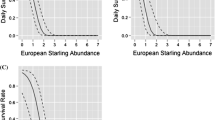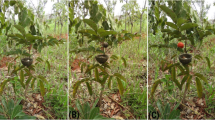Abstract
Three factors and their interaction effects are increasingly recognized as important determinants of nest predation: nest concealment, nest height, and predator type. The risk of nest predation is predicted to vary across these variables because of nest detectability and accessibility. In general, however, few studies examine how these three variables interact in relation to nest predation, focusing instead on either nest concealment or nest height (whereby predator identity is usually not known). In this study, we examine the role of nest concealment and nest height for nest survival using both artificial and natural nests in the superb fairy-wren (Malurus cyaneus). We indirectly identified potential predators through marks left on artificial eggs and footprints left on tracking tunnels. Predation level at artificial nests was lower than at natural nests, and this could be due to a failure of some nest predators to locate cryptic nests in the absence of cues provided by parental activity. Our results supported the prediction that exposed and concealed nests have different levels of nest predation, which can be explained by variation in predator type. Visual predators were only detected at exposed nests, and survival from visual predators was lower for high nests that were also exposed. However, olfactory predators were detected irrespective of nest height or nest concealment. Because rodents use olfaction to locate nests, this could explain the lack of association between nest concealment and predation outcome at low nests. In addition, rodent footmarks near nests were significantly associated with rodent tooth marks on eggs.



Similar content being viewed by others
References
Bayly KL, Blumstein DT (2001) Pied currawongs and the decline of native birds. Emu 101:199–204. doi:10.1071/MU00018
Bergin TM, Best LB, Freemark KE (1997) An experimental study of predation on artificial nests in roadsides adjacent to agricultural habitats in Iowa. Wilson Bull 109:437–448
Berry L, Lill A (2003) Do predation rates on artificial nests accurately predict predation rates on natural nests? The effects of nest type, egg type and nest-site characteristics. Emu 103:207–214. doi:10.1071/MU02054
Boulton RL, Clarke MF (2003) Do yellow-faced honeyeater (Lichenostomus chrysops) nests experience higher predation at forest edges? Wildl Res 30:119–125. doi:10.1071/WR02055
Boulton RL, Cassey P, Schipper C, Clarke MF (2003) Nest site selection by yellow-faced honeyeaters Lichenostomus chrysops. J Avian Biol 34:267–274. doi:10.1034/j.1600-048X.2003.03062.x
Bradley E, Bradley J (1958) Notes on the behavior and plumage of colour-ringed blue wrens. Emu 58:313–326
Burhans DE, Thompson FR III (1998) Effects of time and nest-site characteristics on concealment of songbird nests. Condor 100:663–672. doi:10.2307/1369747
Clark RG, Wobeser BK (1997) Making sense of scents: effects of odour on survival of simulated duck nests. J Avian Biol 28:31–37. doi:10.2307/3677091
Colombelli-Négrel D, Kleindorfer S (2008) In superb fairy wrens (Malurus cyaneus), nuptial males have more blood parasites and higher haemoglobin concentration than eclipsed males. Aust J Zool 56:117–121. doi:10.1071/ZO07072
Colombelli-Négrel D, Robertson J and Kleindorfer S (2009) A new audio-video technique for effectively monitoring nest predation and the behaviour of nesting birds (in press)
Davidson WB, Bollinger E (2000) Predation rates on real and artificial nests of grassland birds. Auk 117:147–153. doi:10.1642/0004-8038(2000)117[0147:PRORAA]2.0.CO;2
Dunn PO, Cockburn A (1998) The costs and benefits of extra-group mating in superb fairy-wrens. Ornithological monograph. Avian Reprod Tactics Female Male Perspect 49:147–162
Filliater TS, Breitwisch R, Nealen PM (1994) Predation on Northern Cardinal nests: does choice of nest site matter? Condor 96:761–768. doi:10.2307/1369479
Flaspohler DJ, Temple SA, Rosenfield RN (2000) Relationship between nest success and concealment in two ground-nesting passerines. J Field Ornithol 71:736–747
Ford HA, Noske S, Bridges L (1986) Foraging of birds in eucalypt woodland in north-eastern New South Wales. Emu 86:168–179
Fulton GR, Ford HA (2003) Quail eggs, modelling clay eggs, imprints and small mammals in an Australian woodland. Emu 103:255–258. doi:10.1071/MU02007
Galligan TH, Kleindorfer S (2008) Support for the nest mimicry hypothesis in yellow-rumped thornbills (Acanthiza chrysorrhoa). Ibis 150:550–557. doi:10.1111/j.1474-919X.2008.00819.x
Gardner JL (1998) Experimental evidence for edge-related predation in a fragmented agricultural landscape. Aust J Ecol 23:311–321. doi:10.1111/j.1442-9993.1998.tb00736.x
Götmark F, Blomqvist D, Johansson OC, Bergkvist J (1995) Nest site selection: a trade-off between concealment and view of the surroundings? J Avian Biol 26:305–312. doi:10.2307/3677045
Green DJ, Cockburn A, Hall ML, Osmond HL, Dunn PO (1995) Increased opportunities for cuckoldry may be why dominant male fairy-wrens tolerate helpers. Proc R Soc Lond B Biol Sci 262:297–303. doi:10.1098/rspb.1995.0209
Hasler N, Klette R, Rosenhahn B, Agnew W (2004) Footprint recognition of rodents and insects. In: Pariman D, North H, McNeill S (eds) Image and vision computing 2004. Landcare Research Ltd, Akaroa, pp 167–172
Hatchwell BJ, Russell AF, Fowlie MK, Ross DJ (1999) Reproductive success and nest-site selection in a cooperative breeder: effect of experience and a direct benefit of helping. Auk 116:355–363
Holway DA (1991) Nest-site selection and the importance of nest concealment in the black-throated blue warbler. Condor 93:575–581. doi:10.2307/1368189
Johnson DH (1979) Estimating nest success: the Mayfield method and an alternative. Auk 96:651–661
King DI, Degraaf RM, Griffin CR, Maier TJ (1999) Do predation rates on artificial nests accurately reflect predation rates on natural bird nests? J Field Ornithol 70:257–262
Kleindorfer S (2007) Nesting success in Darwin’s small tree finch (Camarhynchus parvulus): evidence of female preference for older males and more concealed nests. Anim Behav 74:795–804. doi:10.1016/j.anbehav.2007.01.020
Kleindorfer S, Hoi H, Fessl B (1996) Alarm calls and chick reactions in the moustached warbler. Anim Behav 51:1199–1206. doi:10.1006/anbe.1996.0125
Kleindorfer S, Fessl B, Hoi H (2003) The role of nest site cover for parental nest defence and fledging success in two Acrocephalus warblers. Avian Sci 3:21–29
Kleindorfer S, Fessl B, Hoi H (2005) Avian nest defence behaviour: assessment in relation to predator distance and type, and nest height. Anim Behav 69:307–313. doi:10.1016/j.anbehav.2004.06.003
Kleindorfer S, Lambert S, Paton DC (2006) Ticks (Ixodes sp) and blood parasites (Haemoproteus sp) in New Holland honeyeaters (Phylidonyris novaehollandiae): evidence for site specificity and fitness costs. Emu 106:113–118. doi:10.1071/MU05055
Lambert S, Kleindorfer S (2006) Nest concealment not human visitation predicts nest predation in New Holland honeyeaters. Emu 106:63–68. doi:10.1071/MU05006
Langmore NE, Mulder RA (1992) A novel context for bird song : predator calls prompt male singing in the kleptogamous superb fairy-wren, Malurus cyaneus. Ethology 90:143–153
Maier TJ, Degraaf RM (2001) Differences in depredation by small predators limit the use of plasticine and zebra finch eggs in artificial-nest studies. Condor 103:180–183. doi:10.1650/0010-5422(2001)103[0180:DIDBSP]2.0.CO;2
Martin TE (1987) Artificial nest experiments: effects of the nest appearance and type of predator. Condor 89:925–928. doi:10.2307/1368547
Martin TE (1988a) Nest placement: implications for selected life-history traits, with special reference to clutch size. Am Nat 132:900–910. doi:10.1086/284896
Martin TE (1988b) On the advantage on being different: nest predation and the coexistence of bird species. Proc Natl Acad Sci USA 85:2196–2199. doi:10.1073/pnas.85.7.2196
Martin TE (1993) Nest predation and nest sites: new perspectives and old patterns. Bioscience 43:523–532. doi:10.2307/1311947
Martin TE, Scott J, Menge C (2000) Nest predation increases with parental activity: separating nest site and parental activity effects. Proc R Soc Lond B Biol Sci 267:2287–2293. doi:10.1098/rspb.2000.1281
Mayfield HF (1975) Suggestions for calculating nest success. Wilson Bull 87:456–466
McGuire A, Kleindorfer S (2007) Nesting success and apparent nest-adornment in diamond firetails (Stagonopleura guttata). Emu 107:44–51. doi:10.1071/MU06031
Meilvang D, Moksnes A, Roskaft E (1997) Nest predation, nesting characteristics and nest defence behaviour of fieldfares and redwings. J Avian Biol 28:331–337. doi:10.2307/3676947
Montgomerie RD, Weatherhead PJ (1988) Risks and rewards of nest defence by parent birds. Q Rev Biol 63:167–187. doi:10.1086/415838
Muchai M, Du Plessis MA (2005) Nest predation of grassland bird species increases with parental activity at the nest. J Avian Biol 36:110–116. doi:10.1111/j.0908-8857.2005.03312.x
Mulder RA (1997) Extra-group courtship displays and other reproductive tactics of superb fairy-wren. Aust J Zool 45:131–143. doi:10.1071/ZO96041
Mulder RA, Dunn PO, Cockburn A, Lazenby-Cohen KA, Howell MJ (1994) Helpers liberate female fairy-wrens from constraints on extra-pair mate choice. Proc R Soc Lond B Biol Sci 255:223–229. doi:10.1098/rspb.1994.0032
Nias RC (1986) Nest-site characteristics and reproductive success in the superb fairy-wren. Emu 86:139–144
Nias RC (1987) Co-operative breeding in the superb fairy-wren, Malurus cyaneus. PhD Thesis. University of New England, Armidale
Paton DC, Paton JB (1980) The birds of Scott Conservation Park. S Aust Ornithologist 28:120–126
Pietz PJ, Granfors DA (2000) Identifying predators and fates of grassland passerine nests using miniature video cameras. J Wildl Manage 64:71–87. doi:10.2307/3802976
Rangen SA, Clark RG, Hobson KA (1999) Influence of nest-site vegetation and predator community on the success of artificial songbird nests. Can J Zool 77:1676–1681. doi:10.1139/cjz-77-11-1676
Rangen SA, Clark RG, Hobson KA (2000) Visual and olfactory attributes of artificial nests. Auk 117:136–146. doi:10.1642/0004-8038(2000)117[0136:VAOAOA]2.0.CO;2
Remeš V (2005a) Birds and rodents destroy different nests: a study of blackcap Sylvia atricapilla using the removal of nest concealment. Ibis 147:213–216. doi:10.1111/j.1474-919X.2004.00339.x
Remeš V (2005b) Nest concealment and parental behaviour interact in affecting nest survival in the blackcap (Sylvia atricapilla): an experimental evaluation of the parental compensation hypothesis. Behav Ecol Sociobiol 58:326–333. doi:10.1007/s00265-005-0910-1
Ricklefs RE (1969) An analysis of nesting mortality in birds. Contrib Zool 9:1–48
Rix CE (1976) The birds of Sandy Creek Conservation Park. Aust Bird Watcher 6:209–222
Roper JJ (1992) Nest predation experiments with quail eggs: too much to swallow? Oikos 65:528–530. doi:10.2307/3545570
Rowley I (1957) Co-operative feeding of young by superb blue wrens. Emu 57:356–357
Rowley I (1965) The life history of the superb blue wren. Emu 64:251–297
Rowley I, Russell E (1997) Fairy-wrens and grasswrens (Maluridae). Oxford University Press Inc, New York
Santisteban L, Sieving KE, Avery ML (2002) Use of sensory cues by fish crows Corvus ossifragus preying on artificial bird nests. J Avian Biol 33:245–252. doi:10.1034/j.1600-048X.2002.330306.x
Schlotfeldt B, Kleindorfer S (2006) Adaptive divergence in the superb fairy-wren (Malurus cyaneus): a mainland versus island comparison of foraging behaviour, morphology, and vegetation. Emu 106:309–319. doi:10.1071/MU06004
Skutch AF (1985) Clutch size, nesting success and predation on nests of neotropical birds, reviewed. Ornithological Monogr 36:575–594
Thompson FRIII, Burhans DE (2004) Differences in predators of artificial and real songbird nests: evidence of bias in artificial nest studies. Conserv Biol 18:373–380. doi:10.1111/j.1523-1739.2004.00167.x
Tidemann SC (1986) Breeding in three species of fairy-wrens (Malurus): do helpers really help? Emu 86:131–138
Tidemann SC, Schodde R (1989) A test for character displacement among three species of fairy-wrens (Maluridae: Malurus). Emu 89:79–82
Tidemann SC, Green B, Newgrain K (1989) Water turnover and estimated food-consumption in three species of fairy-wren (Malurus spp.). Aust Wildl Res 16:187–194. doi:10.1071/WR9890187
Weidinger K (2002) Interactive effects of concealment, parental behaviour and predators on the survival of open passerine nests. J Anim Ecol 71:424–437. doi:10.1046/j.1365-2656.2002.00611.x
Weidinger K (2004) Relative effects of nest size and site on the risk of predation in open nesting passerines. J Avian Biol 35:515–523. doi:10.1111/j.0908-8857.2004.03244.x
Wilson GR, Brittingham MC (1998) How well do artificial nests estimate success of real nests? Condor 100:357–364. doi:10.2307/1370277
Acknowledgments
We thank the following organizations for financial support: Australian Research Council, Department for Environment and Heritage, and Mark Mitchell Foundation with awards to Sonia Kleindorfer, and the Holsworth Foundation with awards to Diane Colombelli-Négrel. This study was approved by the Animal Welfare Committee at Flinders University. We thank students from the Bird Lab for helpful assistance in the field.
Author information
Authors and Affiliations
Corresponding author
About this article
Cite this article
Colombelli-Négrel, D., Kleindorfer, S. Nest height, nest concealment, and predator type predict nest predation in superb fairy-wrens (Malurus cyaneus). Ecol Res 24, 921–928 (2009). https://doi.org/10.1007/s11284-008-0569-y
Received:
Accepted:
Published:
Issue Date:
DOI: https://doi.org/10.1007/s11284-008-0569-y




